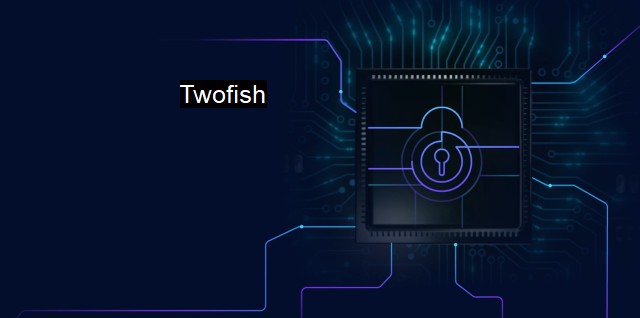What is Twofish?
Exploring the Power of Twofish: A Versatile and Highly Effective Symmetric Key Encryption Algorithm in the Cybersecurity and Antivirus Industries.
Twofish is an intricate topic with roots embedded in the sphere of cybersecurity, playing a pivotal role in data protection and confidentiality. The name might seem quaint, but beneath its surface, Twofish is a symmetric key block cipher, a potent tool embedded in encryption systems, becoming a contender for maintaining the security of information in the cyber world.The cybersecurity landscape fundamentally relies on advanced cryptographic techniques and block ciphers such as Twofish are essential to maintain high level security. Being a symmetric key block cipher means that the same cryptographic key is employed for both the encryption of the plain text and the decryption of the cipher text. Sharing properties with Data Encryption Standard (DES) and Advanced Encryption Standard (AES), Twofish is structured as a Feistel network - a symmetric structure used in the construction of block ciphers, mandatory in ensuring unparalleled safety within digital systems.
Twofish was first introduced to the cybersecurity domain by Bruce Schneier, a prominent figure renowned for his significant contributions to data algorithm techniques. The significant aspect that distinguishes Twofish from various encryption techniques is primarily its flexibility, particularly evident in its keys. A Twofish key can range from 128, 192, or to 256 bits, which increases the complexity of brute forcing the encryption, thereby effectively protecting the data.
Twofish’s algorithm manipulates data in 16 rounds, each introducing a new level of intricacy against potential threats. A fundamental layer of these rounds includes the use of substitution-boxes, or S-boxes, instrumental for manipulating chunks of data independently, providing the necessary complexity for shadowing data securely. Coupled with these S-boxes, pseudo-Hadamard transforms, and modular addition with constants and key material create a steeled force against brute force attacks, ensuring that data sits securely.
It can also be blindingly fast, particularly when implemented in hardware cancellations. Though this versatility can make the implementation slightly more complex, this is outweighed by its advantage of being scalable to a variety of platforms and applications, without losing its roaming speed. Yet it's in the smaller systems where Twofish truly excels. The cipher uses pre-computed tables, meaning that it can operate incredibly efficiently in settings with little available memory, gaining popularity for embedded systems and mobile communications.
Twofish’s cipher’s resistance to common hacker tactics is one of its most admirable attributes. Techniques such as linear and differential cryptanalysis - tricks hackers use to predict the keys used to encrypt the data - falter against Twofish’s powerful cryptographic algorithm, making it a resilient choice for those basing systems where information confidentiality and data integrity is the main issue.
Twofish has yet to dethrone AES (its main competitor) to become the de facto standard for block encryption. Despite AES having a simpler design than Twofish, Twofish outweighs AES on grounds of security, primarily owing to its key-dependent S-boxes and has a sophistical algebraic structure that thwarts adversaries.
Despite Twofish's strengths, debates continue over its efficiency and speed compared to other algorithms. regardless of this, the fact that Twofish has not been compromised, regardless of considerable public scrutiny, undergirds its worth in the face of cybersecurity specialists and large corporations obsessed with preserving the lifeblood of their operations - data.
In the antivirus context, Twofish is instrumental in maintaining data integrity and encrypting sensitive information. Advanced systems incorporate Twofish into their selective scanning protocols to maintain an additional layer of security and making them hard for malware to infiltrate.
The importance of encryption algorithms – like Twofish – continues to rise as digital data grows exponentially. These encryption technologies fortify the confidence for businesses and society in using digital platforms, reaffirming the understanding that cybersecurity must persist in the constantly shifting technological landscape.

Twofish FAQs
What is Twofish and how is it used in cybersecurity?
Twofish is a symmetric key block cipher algorithm that is used in cybersecurity to encrypt and decrypt data. It provides strong security and is often used in VPNs, disk encryption, and other applications where data protection is critical.How does Twofish compare to other encryption algorithms?
Twofish is considered to be one of the most secure encryption algorithms available. It is faster and more efficient than other algorithms like AES, which makes it an attractive choice for applications that require high security without sacrificing performance.What are some common antivirus software programs that use Twofish?
While Twofish is an encryption algorithm rather than an antivirus software program, it is used in some antivirus solutions to provide secure encryption for sensitive data. Examples of antivirus software programs that may use Twofish include Norton and McAfee.Is Twofish vulnerable to any known attacks?
As far as is currently known, Twofish is highly secure and has not been successfully attacked by any known cryptographic attacks. However, as with any encryption algorithm, there is always the possibility of future vulnerabilities being discovered, so it is important to keep software and security measures up to date.Related Topics
Symmetric encryption Advanced Encryption Standard (AES) Data encryption Cryptographic algorithm Cipher
| | A | | | B | | | C | | | D | | | E | | | F | | | G | | | H | | | I | | | J | | | K | | | L | | | M | |
| | N | | | O | | | P | | | Q | | | R | | | S | | | T | | | U | | | V | | | W | | | X | | | Y | | | Z | |
| | 1 | | | 2 | | | 3 | | | 4 | | | 7 | | | 8 | | |||||||